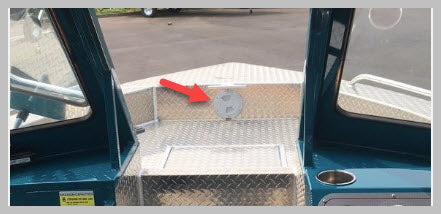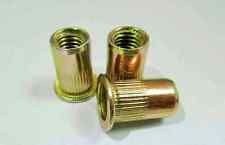How to Mount an Anchor Nest on a Thunder Jet Boat
Posted by ANCHOR CADDIE


Thunder Jet has not, as of this writing, caught up with need customers have with mounting an anchor nest on the bow of their boats, by not having access to nut and bolt under the bow.
I’m sure at some point in the future they will get on board with other aluminum boat manufacturers, but in the meantime, there are a few options that folks use to get it done.
There are 3 options that I know are currently available to mount an anchor nest on a Thunder Jet boat, but the 2 most common options are:
1) Cut a hole on the vertical wall behind the bow deck and install an inspection plate like the picture below. This is the easiest and most economical of the 2. You will now have access to nut & bolt your Anchor Caddie anchor nest.

2) We offer a weld on threaded plate that you weld on the top of the bow. This plate is 1/2" thick aluminum and with the Anchor Caddie hole pattern. Once it is welded on the bow, you just bolt it on with the hardware that comes with our weld on threaded plate. You can see that here, https://www.anchor-caddie.com/products/weld-on-threaded-plate-original-cadet
The last option is using what are called Rivnuts, also called threaded inserts. This method requires a specialized tool to install the rivnuts properly.


Once installed properly, you now have threaded holes on the bow of your Thunder Jet Boat to mount your anchor nest on.
It is also important that the hole pattern is drilled very precise. If the holes drilled are too big, your rivnuts will not hold and you will not be able to use them. If your hole pattern is off too much, you may not be able align your anchor nest on your Thunder Jet boat to insert your bolts.
Although I don’t recommend using this method, if done properly, it is a very effective method and probably the most economical option. But, if in the future, you pull one of them out, you may not be able to get it reinstalled effectively and will end up going back to option 1 or 2.
I hope this helps and let me know if you have any questions or comments, don't hesitate to leave them below or contact us directly.
Paul Anderson
Anchor Caddie




Anchor Caddie On
Hi Tom,
If the cross member is 1-1/2" wide and running front to back, then you would be able to drill holes on each side and put one of our Loads Spreader Plates under the cross member, (https://www.anchor-caddie.com/collections/anchor-nest-accesories/products/load-spreader-plate-original-cadet)
Search “Seahawk” on our website and you will see a blog post and pictures of how that would look. I will also send you an email with the link to that blog post.
If the cross member is wider, you may be able to line your holes up and drill through the cross member, but you would still want to back it up with a load spreader plate.
Hope this helps!
Regards,
Paul Anderson
Tom Caston On
I recently began installing my anchor caddie in my Thunder Jet Chinook. I put an inspection plate on the vertical panel as indicated on your advice above. My plan was to through bolt the anchor caddie with a backing plate. Much to my surprise there are welded structural cross members under the bow plate. I can no longer through bolt the plate. I also have to be very careful where I drill the bolt holes as I might hit a cross member. Suggestions?